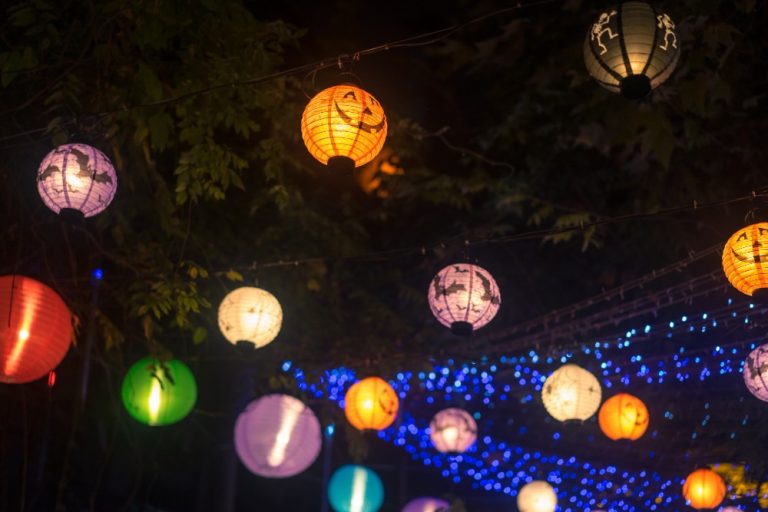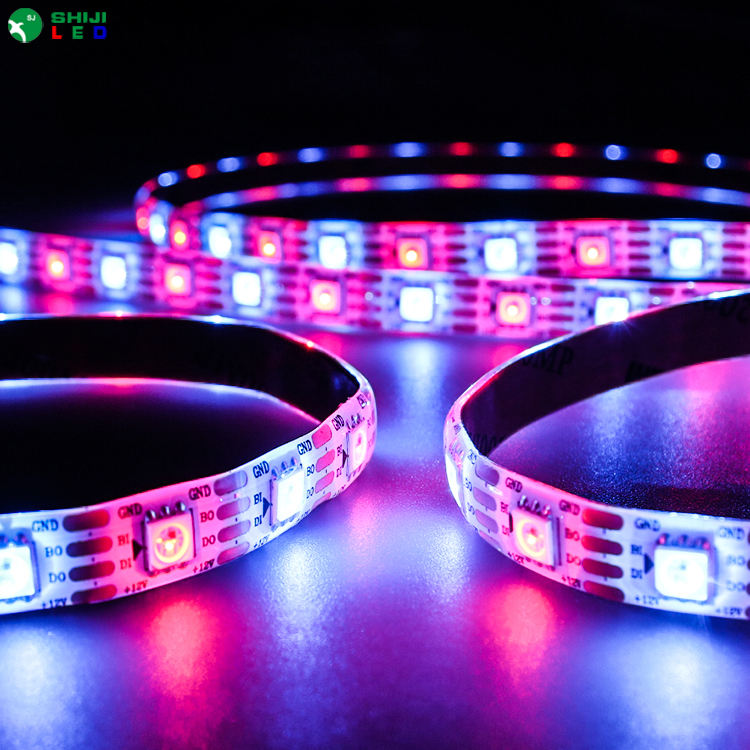Why Do Some Pixel Lights Flicker or Fail to Illuminate Properly?
Common Causes of Flickering in Pixel Lights
Pixel lights can act up, flickering or glowing dimly, for a few reasons. Let’s dig into the main culprits.
Power Supply Instability and Voltage Drops
Pixel lights are picky about power. If the voltage dips below what they need, they’ll flicker or only half-light up. This often happens in long strings of pixel lights, where the wiring’s resistance saps the juice. Extra power wires help fix this. For instance, the 12mm Flat Pixel String Series-Waterproof 5V 12V String Light Point Lighting 12mm DMX RGB Square Smart LED Pixel includes two extra wires to keep the voltage steady across long runs, ensuring the lights shine bright and true.
Incompatible Controllers or Signal Loss
Using the wrong controller or shoddy data lines can make pixel lights act wonky. If the controller doesn’t match the IC chip in your lights, you’ll see flickering or lights dancing out of sync. Shiji Lighting’s products work with controllers like SD controller, DMX controller, or Artnet, which play nicely with IC chips like WS2811, SK9822, or UCS2903, keeping everything in harmony.
Effective Solutions for Stable Illumination
To keep your lights glowing steadily, you need to tackle power and signal issues head-on.
Using Regulated Power Supplies and Signal Amplifiers
A steady power supply is a must to stop flickering. Regulated power sources keep the voltage consistent, so your lights don’t dim or flash. Also, signal amplifiers or repeaters, popped in after a set number of pixels, keep the data strong along the chain. This matters a lot for big outdoor displays or commercial setups, where you want every light to shine bright.
Ensuring Proper Wiring and Grounding Techniques
Good wiring habits make a big difference. Connect the polarity correctly, ground the system properly, and don’t string too many lights without extra power points. Shiji Lighting’s products come with waterproof connectors and clear polarity markings, making it easy to set things up right.
How Shiji Lighting’s Design Minimizes Flickering Issues
Shiji Lighting builds products to dodge flickering troubles from the get-go.
Built-in Voltage Stabilization Features
Our designs at Shiji Lighting tackle voltage issues smartly. Take the Customized WS2811 24V RGB LED Pixel Point Waterproof Amusement Decoration Light—it runs at 24V and uses just 4.32W per unit. This lets you string longer runs with fewer power injections, keeping the lights steady without extra fuss.
Enhanced IC Chip Integration for Consistent Output
We use top-notch IC chips like SK9822, APA102, or GS8208 in our pixel lights. These chips handle signals like champs, keeping colors precise and lights in sync, even in tough setups. Whether it’s a sprawling outdoor display or a tight indoor setup, our chips keep the show running smoothly.
What Causes IC Chips in Pixel Lights to Overheat?
Factors Leading to Excessive Heat Generation
IC chips can get toasty, and that’s trouble for your lights. Let’s break down why.
Continuous High-Current Operation
Running pixel lights at full blast all the time pulls a lot of current, making IC chips heat up fast. This is especially bad in packed lighting setups, where heat builds up like a summer bonfire.
Poor Heat Dissipation in Enclosed Installations
If your lights are stuffed in tight spaces with no air to breathe, the heat from LEDs and IC chips can’t escape. Over time, this heat stress wears down parts or breaks them for good.
Preventive Measures and Cooling Solutions
Keeping things cool is key to long-lasting lights.
Installing with Adequate Ventilation and Heat Sinks
Give your lights some breathing room to let heat drift away. In heavy-duty setups, add passive heat sinks or even fans to pull heat off.
Choosing Energy-Efficient Pixel Lights from Shiji Lighting
Shiji Lighting’s products are built to stay cool while shining bright. Our G40 40mm Christmas Light RGB SK9822 GS8208 IP67 5V 12V LED Pixel String Lighting gives you vivid colors with low power draw, thanks to smart chip designs that keep heat low.
How We at Shiji Lighting Address Thermal Management
We design our lights to keep the heat down and performance up.
Low-Power Consumption Architecture for Cooler Operation
Our pixel lights use low-power SMD5050 RGB LEDs paired with efficient ICs like UCS1903 or WS2811. These parts sip power, not guzzle it, so they stay cooler even in hot weather or tight setups.
Why Are Some Pixel Lights Unresponsive or Out of Sync?
Root Causes Behind Signal Interference or Data Corruption
When lights don’t respond or fall out of step, signal issues are often to blame.
EMI from Nearby Devices or Long Cable Runs
Electromagnetic interference from nearby gadgets or long, unshielded cables can mess up control signals. This leaves lights unresponsive or flashing out of sync.
Faulty Data Transmission Between IC Chips
If one pixel’s chip fails—say, from a bad solder joint or damage—it can stop the signal cold, leaving downstream lights dark or offbeat. Since most pixel systems pass signals in a chain, one bad link can ruin the whole show.
Step-by-Step Fixes for Synchronization Problems
Fixing sync issues takes a bit of know-how, but it’s doable.
Implementing Shielded Cabling and Shorter Distances
Shielded cables block out EMI, keeping signals clean. Also, keep cable runs short to avoid signal fade. Placing controllers close to the first pixel helps start the signal strong.
Utilizing Shiji Lighting’s Advanced Protocol Compatibility
Shiji Lighting’s products work with slick protocols like DMX512 and Artnet through controllers like SD card systems. Our Mini Pixel Pebble String Series uses robust ICs like WS2811 and SM16716 for pixel-by-pixel control, keeping complex setups in perfect sync.
Are Installation Errors Affecting Your Pixel Light Performance?
Common Mistakes During Installation That Lead to Malfunctions
Bad setups can tank your lights’ performance. Here’s what to watch out for.
Incorrect Polarity Connections or Overloaded Circuits
Mixing up polarity can fry LEDs in a snap. Overloading circuits with too many lights pulls too much current, leading to overheating and breakdowns.
Ignoring Manufacturer Guidelines on Spacing and Layouts
Spacing pixels wrong messes up the look, while ignoring layout rules leads to uneven power, with far-end lights dimming like fading stars. Following the maker’s guide keeps everything bright and even.
Best Practices for a Reliable Setup Process
Good installation habits make all the difference.
Following Shiji Lighting’s Installation Manuals Precisely
Shiji Lighting provides clear manuals with every product, packed with wiring diagrams, controller settings, max chain lengths per voltage, spacing tips, and waterproofing steps. Following these ensures your lights shine right from day one.
Adopting Modular Layouts for Easier Maintenance
Breaking big setups into smaller chunks makes troubleshooting a breeze. If one part fails, you can fix it without tearing down the whole system. Our 20mm Cabochon Park Lights SMD5050 RGB 12V LED Pixel comes with waterproof connectors for easy swaps, keeping maintenance as simple as pie.
How Can You Reduce Power Consumption Without Sacrificing Brightness?
The Relationship Between Energy Efficiency and LED Performance
Bright lights don’t have to guzzle power. Let’s see how to balance the two.
High-Lumen Output with Low Wattage: Is It Possible?
Yes, it’s doable. Modern SMD5050 RGB LEDs pump out vivid colors with less power than older models, thanks to better chip designs and optics.
Smart Solutions to Save Electricity While Maintaining Quality Light Output
Shiji Lighting’s controllers offer neat tricks like Bluetooth app control, letting you set timers, tweak brightness based on daylight, or turn off unused sections. This saves power while keeping your display dazzling.
Our Commitment at Shiji Lighting to Energy-Saving Innovation
Since 2010, Shiji Lighting has focused on digital LED solutions that blend stunning visuals with smart power use. All our products, including custom jobs, are built to sip energy while shining bright, backed by a solid two-year warranty. We aim to meet global green goals like those set at COP28, keeping your displays vibrant and eco-friendly.
FAQ
Q: Why do my pixel lights flicker when I turn them on?
A: Flickering often comes from shaky power or voltage drops in long wires. Using steady power sources fixes this quickly.
Q: What causes some LEDs in a strip not to light up?
A: Bad connections, wrong polarity, or a busted IC chip can stop the signal, leaving some lights dark.
Q: How do I stop my pixel lights from overheating?
A: Don’t run them at full brightness all the time. Ensure good airflow around the setup. Pick low-power models built for cool operation.
Q: Can I use any controller with my pixel lights?
A: No, the controller must match the light’s protocol, like WS2811 or DMX512. Always check compatibility first.
Q: How do I save electricity while still getting bright lighting effects?
A: Use app-controlled dimmers or timers. Choose high-efficiency models with strong lumens per watt. Set up modular zones to light only what you need.



